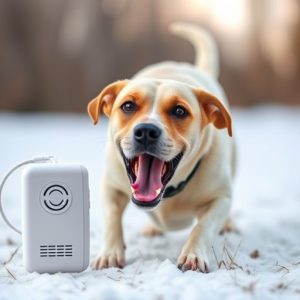Ultrasonic Dog Repeller Devices: A Power Consumption Review
Dogs communicate through body language, vocalizations, and scent marking, requiring understanding fo…….
Dogs communicate through body language, vocalizations, and scent marking, requiring understanding for effective training. Traditional methods like positive reinforcement are successful, while negative reinforcement can induce fear. Modern ultrasonic dog repeller devices use high-frequency sound waves to deter unwanted behaviors, consuming minimal power thanks to long-lasting batteries. A critical review of these devices' power consumption reveals varying energy requirements across models, with more power-efficient options offering both effective training and environmental friendliness.
Introducing the revolutionary ultrasonic dog behavior correction tool – a modern approach to training your furry friend. This article explores the intricate world of canine behavior and delves into innovative solutions like ultrasonic repellers. We’ll dissect traditional training methods and introduce you to these high-tech devices, explaining their functionality and effectiveness. Furthermore, our in-depth review focuses on a critical aspect: power consumption analysis of dog repeller tools, offering a comprehensive guide for informed choices.
- Understanding Dog Behavior and Traditional Training Methods
- Introduction to Ultrasonic Dog Repeller Devices: How They Work
- Power Consumption Analysis of Dog Repeller Tools: A Comprehensive Review
Understanding Dog Behavior and Traditional Training Methods
Dogs, like humans, have unique personalities and behavior patterns that can vary greatly from one pup to another. Understanding a dog’s behavior is crucial for effective training and fostering a harmonious relationship with your pet. Dogs use various forms of communication, including body language, vocalizations, and scent marking, to express their emotions and needs. For example, barking can signal excitement, fear, or a request for attention, while tail wagging indicates happiness or submission.
Traditional training methods have long been the go-to for teaching dogs good behavior. Positive reinforcement, such as rewards and praise, has proven effective in encouraging desirable actions. Conversely, negative reinforcement like scolding or punishment can create fear and anxiety, leading to potential behavioral issues. With advancements in technology, innovative tools like ultrasonic dog repeller devices have emerged, offering a modern approach to behavior correction. These devices emit high-frequency sound waves that are unpleasant to dogs, acting as a deterrent for unwanted behaviors like barking excessively. However, it’s essential to note that their power consumption and effectiveness remain key considerations, as reviewed by various sources, to ensure they align with your training goals and the well-being of your furry friend.
Introduction to Ultrasonic Dog Repeller Devices: How They Work
Ultrasonic dog repeller devices have gained popularity as a humane and effective way to modify canine behavior. These innovative tools utilize high-frequency sound waves, often above the human hearing range, to create a deterring effect on dogs. When activated, the device emits an ultrasonic signal that is perceived as an unpleasant noise or vibration by canines, encouraging them to avoid the area. Unlike traditional punitive methods, it does not harm or cause physical discomfort to the pet.
The power consumption of these devices is often a point of interest for potential buyers. In terms of Dog Repeller Device Power Consumption Review, modern ultrasonic repellers are designed with energy efficiency in mind. They typically operate on small batteries that can last for several weeks or months between charges, making them convenient and hassle-free to use. This feature not only reduces the environmental impact but also ensures consistent performance without frequent replacements.
Power Consumption Analysis of Dog Repeller Tools: A Comprehensive Review
Ultrasonic dog behavior correction tools have gained popularity as a non-violent method to train pets. However, one critical aspect often overlooked is the power consumption of these devices. A comprehensive review of dog repeller tools should include an in-depth analysis of their energy usage patterns. Power consumption varies across models, with some more efficient than others.
This review examines the power requirements and operational longevity of various dog repeller devices, highlighting key differences in design and energy efficiency. Understanding these factors is essential for pet owners to make informed choices, ensuring both effective training and sustainable use. The analysis reveals that while some tools offer high-intensity ultrasonic emissions, they may also consume significant amounts of electricity over time. Conversely, more power-efficient models strike a balance between performance and energy conservation, making them environmentally friendly options for responsible dog ownership.
Ultrasonic dog behavior correction tools offer a modern approach to training, utilizing sound waves to gently guide canine behavior. This innovative technology provides an alternative to traditional methods, addressing power consumption concerns with recent advancements in device efficiency. By understanding dog behavior and leveraging the right tools, pet owners can effectively train their pets while ensuring their well-being. A comprehensive Dog Repeller Device Power Consumption Review highlights the importance of choosing energy-efficient options, contributing to both responsible pet ownership and environmental sustainability.


